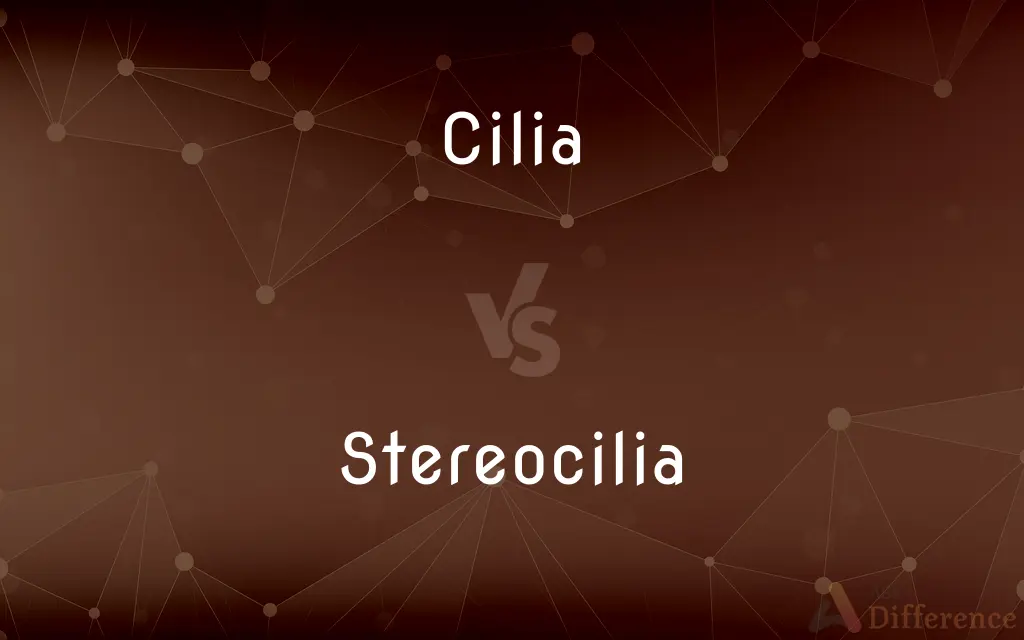Cilia vs. Stereocilia — What's the Difference?
By Tayyaba Rehman — Updated on September 30, 2023
Cilia are microscopic, hair-like structures that move in coordinated waves, aiding in cell movement and filtration, while Stereocilia are non-motile, elongated microvilli found primarily in the inner ear, involved in detecting sound and balance.

Difference Between Cilia and Stereocilia
Table of Contents
ADVERTISEMENT
Key Differences
Cilia and Stereocilia serve distinct roles within cellular structures, aiding in varied physiological functions. Cilia are small, hair-like projections extending from the surface of cells, possessing the ability to move rhythmically. Their motion propels substances like mucus and aids in cellular movement. In contrast, Stereocilia do not have motility; they are long, stiff protrusions present primarily in the inner ear, playing a critical role in the detection of sound waves and maintaining equilibrium.
The function of Cilia is diverse, including sensory roles and contributing to the proper functioning of respiratory and reproductive systems. They can detect chemical changes in the environment and are instrumental in the movement of eggs through the female reproductive tract. Stereocilia, however, have a specialized function predominantly related to hearing and balance. Their deformation due to sound vibrations or head movements activates sensory cells, translating into electrical signals interpreted by the brain.
While Cilia are characterized by their ability to move, possessing a complex internal structure that includes microtubules allowing for their motion, Stereocilia lack this intricate internal organization and do not exhibit movement. The differences in structural organization and mobility mean that Cilia can actively participate in various physiological processes, while Stereocilia’s role is largely passive, reacting to external stimuli.
In terms of localization, Cilia can be found on a wide array of cells throughout the body, such as those lining the respiratory and reproductive tracts. Stereocilia are more specifically located, predominantly found in the hair cells of the inner ear, where their sensitivity to mechanical stimuli is crucial for auditory and vestibular functions.
In summary, Cilia are multifunctional, motile structures participating in processes ranging from sensation to transportation of substances across cell surfaces, due to their organized, dynamic structure. Stereocilia are specialized, immobile protrusions with a role primarily in the transduction of mechanical stimuli in the auditory and vestibular systems, responding to the mechanical movements they encounter.
ADVERTISEMENT
Comparison Chart
Mobility
Motile
Non-motile
Function
Movement and filtration
Detection of sound and balance
Structure
Complex with microtubules
Simpler, lack microtubules
Localization
Various cells throughout the body
Primarily in the hair cells of the inner ear
Role
Active, participate in physiological processes
Passive, respond to external mechanical stimuli
Compare with Definitions
Cilia
Microscopic protrusions that aid in cell movement and the transportation of extracellular materials.
The coordinated movement of cilia on single-celled organisms enables them to navigate their environment.
Stereocilia
Immobile, hair-like structures predominantly located in the inner ear, sensitive to fluid movement.
Stereocilia translate the movement of fluid in the inner ear into signals that the brain interprets as sound or head position.
Cilia
Small, whip-like appendages on the cell surface that are instrumental in cellular locomotion and fluid movement.
The beating of cilia in the trachea helps in keeping the airways clear of mucus and debris.
Stereocilia
Sensory organelles that are vital for the perception of sound waves and the maintenance of equilibrium.
The length and stiffness of stereocilia influence their sensitivity to different frequencies of sound vibrations.
Cilia
Cellular organelles that have a rhythmic, wave-like motion, facilitating filtration and secretion processes.
In the fallopian tubes, the motion of cilia assists in moving the egg towards the uterus.
Stereocilia
Non-motile, elongated projections found in the inner ear, involved in auditory and vestibular sensation.
Stereocilia in the cochlea bend in response to sound vibrations, initiating the process of hearing.
Cilia
Motile structures that are involved in sensory perception and play a role in various physiological systems.
Sensory cilia detect changes in the cellular environment, initiating adaptive responses.
Stereocilia
Specialized cellular structures that respond to mechanical stimuli and are crucial for maintaining balance.
The deformation of stereocilia due to head movements sends signals to the brain about the body’s position in space.
Cilia
Tiny, hair-like structures projecting from cell surfaces, enabling movement and sensory functions.
Cilia lining the respiratory tract move in coordinated waves to transport mucus, trapping and removing foreign particles.
Stereocilia
Small, rigid protrusions on hair cells, playing a key role in the conversion of mechanical vibrations to electrical signals.
Damage to stereocilia can result in hearing loss as they are essential for sound transduction.
Cilia
Plural of cilium.
Stereocilia
Stereocilia (or stereovilli) are non-motile apical modifications of the cell. They are distinct from cilia and microvilli, but closely related to the latter.
Cilia
Plural of cilium
Stereocilia
Plural of stereocilium
Cilia
The eyelashes.
Cilia
Small, generally microscopic, vibrating appendages lining certain organs, as the air passages of the higher animals, and in the lower animals often covering also the whole or a part of the exterior. They are also found on some vegetable organisms. In the Infusoria, and many larval forms, they are locomotive organs.
Cilia
Hairlike processes, commonly marginal and forming a fringe like the eyelash.
Cilia
Small, vibratory, swimming organs, somewhat resembling true cilia, as those of Ctenophora.
Common Curiosities
Do cilia have a role in sensory perception?
Yes, cilia, especially primary cilia, have sensory roles, detecting environmental stimuli and signaling changes within cells.
Are cilia found in all cell types?
No, cilia are not found in all cell types; they are typically present in specific cells like those in the respiratory tract.
Are stereocilia and cilia structurally similar?
While they share some superficial resemblance, they differ significantly in structure and function.
Is the movement of cilia energy-intensive?
Yes, the movement of cilia requires energy, typically derived from ATP.
Are all cilia motile?
No, there are also primary cilia that are generally non-motile and play a sensory role.
Can damage to stereocilia be repaired?
Typically, damage to stereocilia is irreversible and can lead to permanent hearing loss.
Can defects in cilia lead to diseases?
Yes, defects in cilia can lead to a range of diseases known as ciliopathies, affecting various bodily systems.
Are cilia only present in humans?
No, cilia are found in a wide range of organisms, including single-celled organisms and animals.
Can damage to stereocilia affect balance?
Yes, damage to stereocilia can disrupt the vestibular system, affecting balance and spatial orientation.
Can the length of cilia vary?
Yes, the length of cilia can vary depending on the cell type and their specific function.
Is the function of cilia only related to movement?
No, besides movement, cilia also play roles in sensation, signal transduction, and developmental processes.
Do stereocilia regenerate?
Stereocilia have limited regenerative capacity, and damage is often permanent.
Are stereocilia involved in the detection of all sound frequencies?
Yes, different stereocilia respond to different frequencies, allowing the detection of a range of sounds.
Is the number of stereocilia uniform in all hair cells?
No, the number of stereocilia can vary between different hair cells.
Are stereocilia only found in the inner ear?
Stereocilia are predominantly found in the inner ear but can also be present in some other sensory organs.
Share Your Discovery

Previous Comparison
Deliverer vs. Savior
Next Comparison
Avow vs. AverAuthor Spotlight
Written by
Tayyaba RehmanTayyaba Rehman is a distinguished writer, currently serving as a primary contributor to askdifference.com. As a researcher in semantics and etymology, Tayyaba's passion for the complexity of languages and their distinctions has found a perfect home on the platform. Tayyaba delves into the intricacies of language, distinguishing between commonly confused words and phrases, thereby providing clarity for readers worldwide.














































